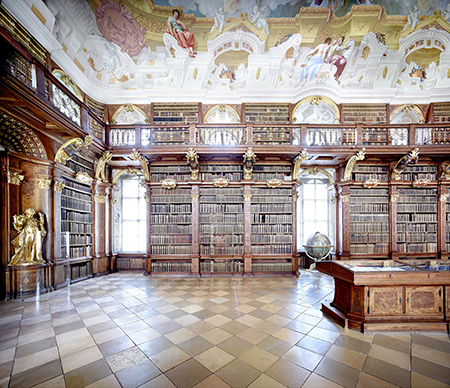
Continuing through December 22, 2017
Candida Höfer’s current exhibition, titled "Spaces and Places," shows the conceptual photographer — who was a student, like Andreas Gursky and Thomas Ruff, of Bernd and Hilla Becher — continuing her examination of empty architectural spaces. Among the fourteen color photographs on display are five large-format works, formally composed, often frontally or even symmetrically, that deliver beauty and power, with only a hint of social critique. Höfer’s depictions of these grand institutional spaces — libraries, palaces, and symphony halls — exult in glory and grandiosity, but also implicitly question their functionality or permanence. These a0re habitats without inhabitants, like museum reconstructions of Renaissance palazzi.
Of these, the “Elbphilharmonie Hamburg, Herzog & de Meuron, Hamburg X” is the most stunning example of the artist’s “architecture of absence,” with rows of blue seats on several tiers bordering the arena-like orchestral stage, echoing its form like radiating sound waves. A mushroom-shaped chandelier worthy of a UFO mother ship descends from above, its myriad lights repeating the mirrored panels placed on the walls behind the orchestra (Herzog & de Meuron also designed the deYoung Museum in San Francisco). Almost as remarkable, and more antiquarian and aristocratic, is “Benediktinerstift Melk III,” a view of a library wall in the Baroque Melk Abbey, in Austria, overlooking the Danube. A gilded statue and a table-sized lectern face off on either side across an expanse of tiled floor, leather-bound tomes and trompe-l’oeil ceiling mural. “Palazzo Canossa Mantova III” depicts the landing of a marble stairway in the late Renaissance aristocratic residence in Mantua, its balustrades lined with mythological/allegorical statuary. “Staircase III” is a vertiginous view down seven floors of an ovoid spiral staircase. Too tall to be displayed vertically, it is hung horizontally in the gallery — with no loss of effect, but it belongs in the proper setting of some contemporary merchant prince’s fortress of solitude. (It’s oriented properly in the show catalogue.)
Smaller works strike a more personal tone. "Li Yuan Library," in a small village outside Beijing, seems to be constructed of books, although it is made of small pieces of wood, found locally, that is traditionally used for firewood by villagers. The sticks’ resemblance to books, all too evident in Höfer’s trio of photos, suggests that the architects, Li Xiaodong Atelier, may have found common ground between postmodernist vernacularism and the moralizing or symbolic architecture (never built) of the 18-century French visionary, Jean-Jacques Lequeu. Other small works include detail shots of modern buildings: windows seen through a scrim of curtain; teacups on a lap tray parked on a bentwood chair; and the ends of two small pieces of paper affixed to a window, contrasted with background blur: Hans Hofmann push-pull rendered with photo bokeh.
